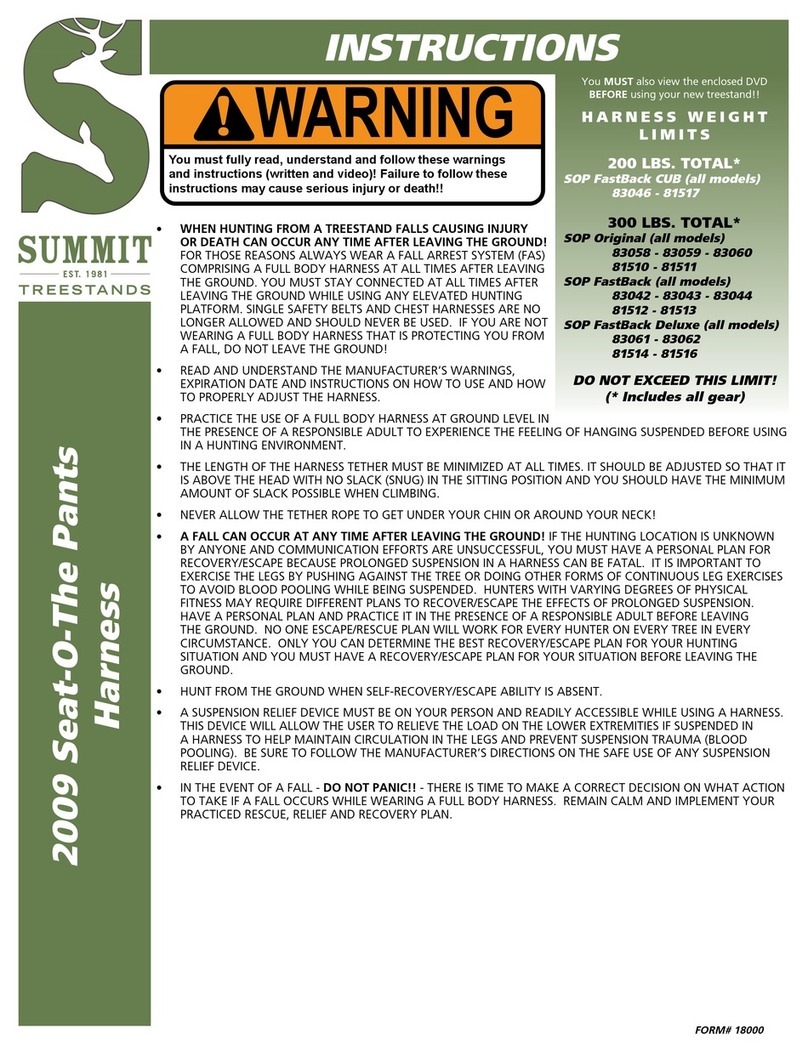
PG 2 www.summitstands.com
TREE SIZE / WEIGHT LIMIT
1
Stand Minimum and Maximum Tree Size: 8-20” Diameter
Weight Limits: (Includes hunters’ combined weight PLUS weight of all gear carried into the treestand)
DO NOT EXCEED THESE WEIGHT LIMITS!
• Several optional products/systems are available that offer self-recovery or self extraction from a fall when
suspended in a harness. Some systems
automatically descend the user while others allow user control. One of these
products/systems could be considered for use as an additional safety
precaution against prolonged suspension and suspension trauma. Be sure to follow manufacturer’s directions on the safe use of these products/systems.
• There is time to make a correct decision on what action to take if a fall occurs while wearing a FBFAHS. It is important to remember to “do not panic”.
Remain calm and implement your practiced rescue, relief, and recovery plan.
• Never use the FBFAHS or treestand while feeling ill, nauseous or dizzy, or if you have prior medical condition that could cause a problem, that is, heart
condition, joints that lock-up, spinal fusions, etc or if you are not well rested.
• Do not use the FBFAHS or treestand if under the inuence of alcohol or drugs (includes prescription medications). This includes over-counter medications
that may cloud or alter judgment or mental state. Consult with your physician before using this product to ensure safe and proper use.
• Never use treestand or FBFAHS during inclement weather such as rain, lightning, windstorms, snow, hail, sleet or icy conditions. End your hunt and return
to the ground if inclement conditions arise.
• Never use on a dead, leaning, diseased or loose bark tree, or utility pole.
• Always maintain three (3) points of contact while climbing a ladder stand or climbing aide. Never be disconnected from the tree when transferring from
your climbing aide to the xed position stand. Practice at ground level before using at a elevated position.
• The Full Body Harness (SU18226-01-H or SU18226-02-H) must be discarded after ve (5) years from the purchase date shown on the label of the
harness, or after arresting a fall, whicever is sooner. If purchase date is unknown, or if you fail to register the product and provide proof of purchase, the
expiration date will revert to 5 years or less from the date of manufacture. Failure to discard this FBFAHS as directed could result in serious injury or death.
• The Lineman’s Belt (SU18226-03-LB or SU18226-04-LB) or Tether Strap (SU18226-01-TS or SU18226-02-TS) must be discarded after two (2) years from
the purchase date shown on the label of the belt or strap, or after arresting a fall, whichever is sooner. If purchase date is unknown, or if you fail to register
the product and provide proof of purchase, the expiration date will revert to 2 years or less from the date of manufacture. Failure to discard this belt or strap
as directed could result in serious injury or death.
300 lb Rated FBFAHS:
SU18226-01
SU18226-03
350 lb Rated FBFAHS:
SU18226-02
SU18226-04
FBFAHS Summit Harness SU18226-01
(300 LB WEIGHT RATING)
• (1) Full Body Harness (SU18226-01-H)
• (1) Tether Strap (SU18226-01-TS)
•• LINEMAN’S BELT / TETHER STRAP MUST BE REPLACED EVERY (2) YEARS
FBFAHS Summit Harness SU18226-03
(300 LB WEIGHT RATING)
• (1) Full Body Harness Harness (SU18226-01-H)
• (1) Lineman’s Belt (SU18226-03-LB)
• (1) Tether Strap (SU18226-01-TS)
•• LINEMAN’S BELT / TETHER STRAP MUST BE REPLACED EVERY (2) YEARS
CONTENTS
2
FBFAHS Summit Harness SU18226-02
(350 LB WEIGHT RATING)
• (1) Full Body Harness (SU18226-02-H)
• (1) Tether Strap (SU18226-02-TS)
•• LINEMAN’S BELT / TETHER STRAP MUST BE REPLACED EVERY (2) YEARS
FBFAHS Summit Harness SU18226-04
(350 LB WEIGHT RATING)
• (1) Full Body Harness Harness (SU18226-02-H)
• (1) Lineman’s Belt (SU18226-04-LB)
• (1) Tether Strap (SU18226-02-TS)
•• LINEMAN’S BELT / TETHER STRAP MUST BE REPLACED EVERY (2) YEARS




























